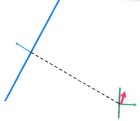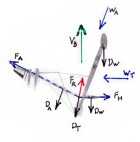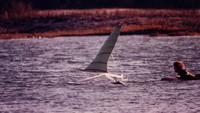High-Speed Sailing
| Vessel Name: | Sailien |
| Vessel Make/Model: | Experimental/custom |
28 September 2013
The America’s Cup
I watched, with interest, the videos of the 34th America’s Cup. At last we have fast sailboats engaged in a competition that is fun to watch. The virtual images (such as course boundaries, distance grid lines, separation between boats, etc.) overlaid on the real images really helps to keep the race [...]
31 August 2013
100 Knots for Hydroptere?
The latest news from Hydroptere is that they have plans for a 100 knot sailboat. This was posted on 26 Aug 2013, so look for that date at this address. http://hydroptere.com/en/the-news/last-news/
17 November 2012
Aptly named Sailrocket, blasts off!
While yet to be ratified, Sailrocket posted an average speed over 500 meters of 59 knots. I will not be surprised if they increase their record into the 60 knot range during this record attempt.
02 January 2012
More drag for VSR2?
I want to start by pointing out that the whole VSR2 team has done a stellar job and has demonstrated conclusively that the forces that drive a sailboat can be aligned for roll stability without using ballast and without using any down-force. (Trifoiler achieved roll stability by using down-force, but [...]
18 December 2011
My analysis of Sailrocket
I copied a diagram of VSR2 (wing doesn’t show well) and added in the major force arrows that apply. Be aware that these arrows are not correct in terms of scale (length) and some of their locations are guesses, however I believe I’m correct enough for us to learn something about what VSR2 has been [...]
23 October 2011
60 is within reach, what’s next?
I have been watching Sailrocket’s progress with great interest and there’s no question they have a winner. I fully expect to see them reach 60kt in the near future. Sailrocket has now demonstrated what I first learned with my models and again with my full-sized prototypes, that if you get the forces [...]
High-Speed ice skate wing
I mentioned in an earlier post that as a kid, I lived near Lake Michigan and always wanted an ice-boat. While I never got that chance (my family moved) I did make a sail for ice skating (I was about 11 years old). Ice skate-sailing was very fast in a breeze even though my sail was quite crude. The biggest problem I noticed was a terrific side-load on my ankles. My skates were cheap hockey skates and had no ankle support; better skate boots were developed much later.
I long considered the heavy ankle side-load to be a major limiting factor for high-speed ice skate-sailing and I never considered that real speed could be generated by that method. It appears that newer technology (better skate boots) and enclosing wings (instead of sails) has boosted speeds tremendously.
In earlier posts I stated that windsurfers and kite-boarders were limited in their speed by the aero-dynamic drag on their bodies and the only way for them to go faster was to find stronger winds (which is exactly what they've been doing), unless they were able to enclose their bodies in an aerodynamic fairing. The ice skate wing is the type of enclosure I was thinking of, but I had no idea that anyone was doing this.
I actually didn't think fairings would be practical for windsurfers or kite-boarders, but I'm starting to re-think that position as a result of seeing the ice skate wings. My first impression when I saw the wings was that control would be impossible because of the body being so confined. However when I remembered my ice skate-sailing experience, I realized that control is not difficult.
I made my skate sail from plans in a Popular Mechanics book "What to Make and How to Make it" (published in the 1930's or1940's). I had never seen anyone skate-sail but at 11 years old, I went out and skate-sailed with no problem. All you do is lean on the wind's force and it's easier than you might think. The difference with the enclosing wing is that the lee side is covered (closed in) with sail fabric as well as the windward side. The difference aerodynamically is about like a piece of plywood compared to a true wing shape.
What I want to point out by all this is the tremendous difference that good aerodynamics (and hydrodynamics) can make. Just remember that the best in fluid dynamics will not get you anywhere if you can't keep it aimed in the right direction. Wot Rocket is our best example of this, but all the top contenders have crashed because of loss of control in either pitch, roll, or yaw. My decision to make a run at the sailing speed record is directly because all the other top contenders have been limited by control problems.
Note that Bernard Smith in "The 40 Knot Sailboat" was suggesting putting the payload in the wing (same idea as the ice skate-wing) and my first prototype was built that way (I sat in the base of the wing on my first two test runs). I abandoned doing that because the weight balance was not optimum. One of our very own Alan Kruppa is using this idea in his "aero-ballast" Radboat (be sure to visit his site). Also Paravane could easily place the pilot in the wing base.
Bob
About & Links
- Bob's Surfing Blog
- Bob's Website
- Greenbird (Windjet)
- l'Hydroptere
- Le Projet Dared
- Macquarie Speed Sailing Team
- Monofoil Sailing
- Mountain Goat STOL
- Mr Smith's Amazing Sailboats
- Patent Office (Search)
- Radboat
- Sailien Prototypes (early), Delta, etc.
- Sailien Video
- Sailien Website
- The Basics of Surfboard Design
- The Basics of Surfboard Design en Espanol
- The Swedish Speed-Sailing Challenge
- Trifoiler
- Vestas Sailrocket
- Windjet Project
- WSSRC


